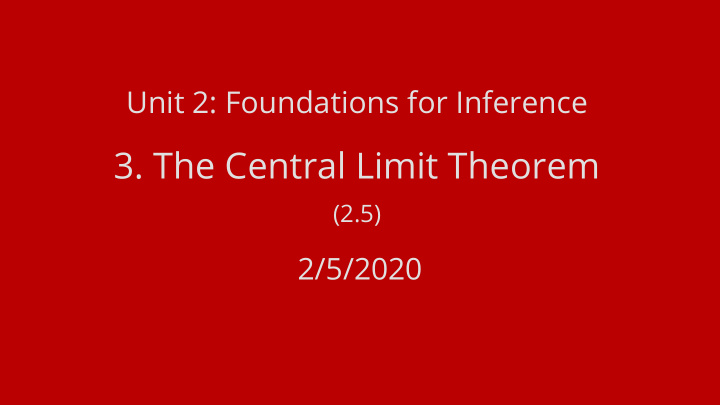



Unit 2: Foundations for Inference 3. The Central Limit Theorem (2.5) 2/5/2020
Quiz 3 - Hypothesis Testing
Recap from last time 1. Null hypothesis testing is a framework for quantifying evidence 2. Whenever we pick a standard of evidence that trades off Type I and Type II errors 3. We generally want to use two-sided tests, increasing our standard for evidence
Key ideas 1. Larger samples give us more precision 2. The Central Limit Theorem says that the Null distribution will generally approach the Normal distribution 3. Using theoretical distributions (instead of shuffled random distributions) makes statistical measures lossless compression
Why large samples matter Intuition: How likely am I to Suppose I want to know if I can guess guess all 4 correctly by the outcomes of coin flips better chance? than chance. Each correct guess has chance I flip the coin four times and guess guessing probability of .5. So correctly three out of four times! guessing 4 in a row is .5 * .5 * .5 * .5 = .0625 So even if guess ALL of them What can we conclude? correctly, we still couldn’t Nothing! reject the null
If our sample is too small, we can never reject the null Even if I have superhuman guessing ability, I can’t tell if I flip 4 coins. I do not have enough statistical power to detect the effect, even if the Alternative Hypothesis is true! So what does power depend on?
Statistical power depends on... My ability to reject the Null Hypothesis depends on: The size of my sample ● The size of the difference between the True value of the ● population parameter and the value of the Null distribution population parameter My p-value criterion ● It is shockingly easy to be in a regime where you can’t infer anything no matter how the data turn out!
Our null distributions so far Difference in proportion of Difference in proportion of Difference in proportion cardiac arrests during cardiac arrests during of women and men meetings and non-meetings meetings and non-meetings promoted at teaching hospitals at non-teaching hospitals What do these distributions have in common?
The Central Limit Theorem The null distribution for a proportion (or difference of proportions) will approximate the Normal Distribution as the sample size approaches infinity. https://gallery.shinyapps.io/CLT_prop/
The Central Limit Theorem The null distribution for a mean of a distribution of any shape will also approach the Normal as the sample size approaches infinity https://gallery.shinyapps.io/CLT_mean/ That’s why the Normal Distribution is everywhere!
Introducing the Normal Distribution Unimodal and symmetric Has two parameters: σ Mean (µ) ● Standard deviation (σ) ● µ The two parameters completely describe a Normal Distribution
Different Normal Distributions Standard Normal Distribution
Descriptive statistics .mp3 and .jpeg are lossy compression -- What’s the difference between .mp3 and .FLAC? they make data .jpeg and .png? smaller by keeping only the most important parts of it. Descriptive statistics are kind of lossy compression: What one/few number(s) that best represent my data. But a distribution’s parameters are lossless compression . They tell you everything there is to know about it.
Detecting distortions by using a distribution’s shape OkCupid users are (likely) misreporting their heights in two ways . What are they? https://blog.okcupid.com/index.php/the-biggest-lies-in-online-dating/
Key ideas 1. Larger samples give us more precision 2. The Central Limit Theorem says that the Null distribution will generally approach the Normal distribution 3. Using theoretical distributions (instead of shuffled random distributions) makes statistical measures lossless compression
Recommend
More recommend